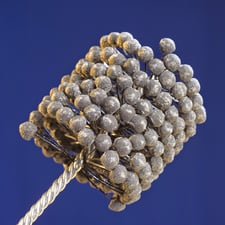 Manufacturers, machinists, and metalworkers want to know which type of cylinder hone is the right choice for their application. Flex-Hone® tools from Brush Research Manufacturing (BRM) are great for deglazing the walls of cylinders that aren’t out-of-round. Flexible hones are also ideal for surface finishing bores that have been honed to size with a rigid hone.
Manufacturers, machinists, and metalworkers want to know which type of cylinder hone is the right choice for their application. Flex-Hone® tools from Brush Research Manufacturing (BRM) are great for deglazing the walls of cylinders that aren’t out-of-round. Flexible hones are also ideal for surface finishing bores that have been honed to size with a rigid hone.
Rigid hones are recommended for some applications, but flexible hones are the right choice for cylinders that don’t require initial honing, resizing, or geometry correction. With their low-temperature, low-pressure abrading process, Flex-Hone® tools won’t remove significant amounts of material. Rather, flexible hones impart the ideal final finish – a plateau finish. Flexible hones are great for cross-hole deburring, too.
Flexible honing offers numerous advantages, but here are five reasons to use Flex-Hone® tools instead of rigid hones.
1. Training, Equipment, and Setups
Flex-Hone® tools don’t require special training, expensive equipment, or complicated setups or clean-ups. You can use BRM ball hones with handheld power tools, or with existing production machinery.
2. Cutting Points And crosshatching
Rigid hones have only two or three stones. Flex-Hone® tools have hundreds of cutting points for a full 360° of cutting action. Importantly, flexible honing creates a crosshatch pattern that helps to increase oil retention.
3. Self-Centering and Self-Aligning
Flex-Hone® tools are self-centering and self-aligning to the bore because each of a flexible hone's abrasive globules have independent suspension.
4. Plateau Finishing
Rigid hones can produce a rough surface finish with high, sharp peaks. Flexible honing removes cut, torn, and folded metal while reducing peaks to a consistent height and creating oil-retaining valleys for a plateau finish.
5. Low, Consistent Pressure
Because the Flex-Hone® puts little pressure on cylinder walls, the tool won’t gouge out metal. Pressure against the wall is equalized, and operators don’t have to worry about making cuts in both directions.
Learn More. Get the Guide.
Flex-Hone® tools help solve the challenges of cylinder surface finishing. But which tool diameter, abrasive type, and grit size do you need? The answers to these and other questions are in the Flex-Hone® Resource Guide. Get your copy to get started.









